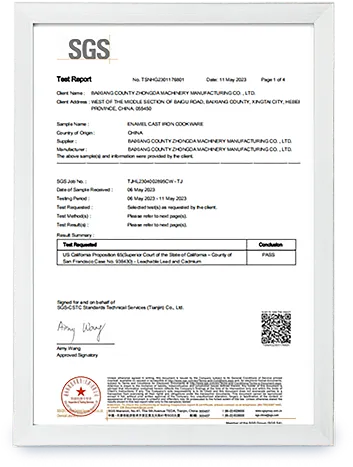
dutch oven types
Exploring Dutch Oven Types A Culinary Essential
A Dutch oven is more than just a cooking pot; it is a versatile kitchen essential that has earned its place in homes around the world. Known for its heavy, cast-iron construction and excellent heat retention properties, a Dutch oven can go from stovetop to oven with ease, making it perfect for a wide range of cooking techniques—from braising and roasting to baking and frying. Understanding the various types of Dutch ovens can help you select the best one for your culinary needs.
1. Enamel-Coated Dutch Ovens
One of the most popular types of Dutch ovens is the enamel-coated variety. These pots are made of cast iron, but they are coated with a layer of enamel that comes in various colors and finishes. The enamel not only adds aesthetic appeal but also helps to prevent rust and eliminates the need for seasoning. Enamel-coated Dutch ovens are excellent for cooking acidic foods, such as tomato-based dishes, which can react negatively with bare cast iron. They are also easier to clean and maintain, making them a favorite for both novice and experienced cooks alike.
2. Bare Cast Iron Dutch Ovens
For those who appreciate traditional cooking methods, bare cast iron Dutch ovens are worth considering. These classic pots require seasoning – a process that creates a natural non-stick surface and enhances the flavor of the food cooked within. While they may require more maintenance than their enameled counterparts, many chefs believe that bare cast iron delivers superior heat retention and distribution. Additionally, with the right care, a well-seasoned Dutch oven can last a lifetime and develop a patina that adds character and depth to your dishes.
dutch oven types

Lightweight Dutch ovens are a newer addition to the Dutch oven family. Made from materials like aluminum or lighter-weight cast iron, these pots provide the same cooking capabilities as traditional models but are easier to handle. Their lighter weight makes them an excellent choice for camping and outdoor cooking, where portability is essential. While they may not have the same heat retention as classic cast iron, they often feature non-stick surfaces and modern designs, making them appealing for those looking for convenience.
4. Double Dutch Ovens
Double Dutch ovens, also known as casseroles, come with two interconnected pots—one for cooking and the other serving as a lid or second cooking vessel. This design allows for versatility in the kitchen, enabling cooks to prepare multiple layers of a dish simultaneously. Double Dutch ovens are fantastic for recipes that require steaming or baking, such as layered casseroles and bread. The ability to cook with two vessels simultaneously can save time and enhance flavor profiles.
5. Specialty Dutch Ovens
Apart from the regular types, there are also specialty Dutch ovens available that cater to specific cooking styles. For instance, there are deeper options that are ideal for frying, as they provide ample space for the splatter. Others come with unique features such as a built-in thermometer for precision cooking or a lightweight design for easy portability. Specialty Dutch ovens expand the possibilities of what you can create in the kitchen, opening the door to new culinary adventures.
Conclusion
Whether you are a novice getting acquainted with the art of cooking or a seasoned chef eager to expand your culinary repertoire, choosing the right type of Dutch oven can make a significant difference. Each type serves a distinct purpose and brings unique advantages to your cooking experience. Whether you prefer the classic charm of a bare cast iron pot or the modern convenience of lightweight options, there is a Dutch oven to suit every taste and cooking style. By investing in a quality Dutch oven, you equip yourself to tackle a variety of dishes, ensuring delicious results every time. Happy cooking!
-
Dutch Oven Slow Cooker: AI Recipes & Even HeatingNewsAug.04,2025
-
Premium Cast Iron Large Griddle | Durable & Even HeatingNewsAug.03,2025
-
Large Cast Iron Griddle Pan-Baixiang County Zhongda Machinery|Non-Stick&Heat RetentionNewsAug.03,2025
-
Cast Iron Cookware Pan- Baixiang County Zhongda Machinery|Non-stick, DurableNewsAug.03,2025
-
Black Cast Iron Pan- ZD Cookware|Non-Stick, Heat ResistantNewsAug.03,2025
-
Cast Iron Cookware Pancake Pan- ZD Cookware|Non-Stick, Even Heat, DurableNewsAug.02,2025


